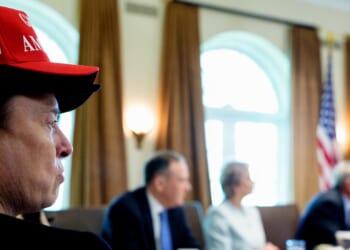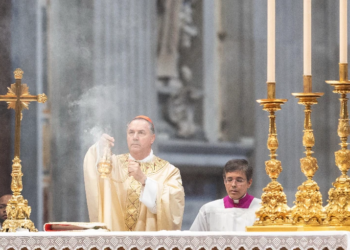Years ago, I was familiar with two young adults from conservative Christian homes entering the world of LGBT activism and identity. Both of their conversions were accompanied by publicly adopting key elements of pagan spirituality. One, a young lady self-identified as “queer” and sported new transgender pronouns, began a side business selling tarot card readings. The other, a male who embraced a bisexual identity, began holding rituals invoking pagan deities. It was not clear to me whether occult practices or gay identity came first. They emerged about the same time.
I have long noticed the partnering of pagan spiritual practices and LGBT identification. These two cases were not isolated. There has been strong evidence, if not much systematic research, of this connection for many years. (RELATED: Media Fawns Over Spiritual Guru Shaping New Age Thought)
For example, Sascha Cohen, writing in a self-described LGBT online publication in 2018, pointed out that in “personal ads from queer women and nonbinary people from around the world, you’ll notice that … the majority of the users cite their star signs.” She goes on: “You’d be forgiven for assuming that literally everyone in our community believes in astrology. Queer women’s culture constantly reinvents itself, but its reliance on divination rituals like astrology … remains fixed.”
She confidently claimed that belief and involvement in them are so strong among LGBT people that those who are skeptics feel alienated from other LGBT folk, and so hide it. “Many told me they feel stigmatized by the larger queer community for their [skeptical] beliefs, and would not allow their full names to be published for that reason.” As one of her interviewees said, “Subscribing to New Age beliefs is ‘part of the rules for being gay/queer.’”
There are other indicators of this connection, well-known in the LGBT community.
An alliance of radical feminist organizations (lesbians, of course, being well represented in these circles), established on Halloween in 1968, went by the acronym W.I.T.C.H. (standing for “Women’s International Terrorist Conspiracy from Hell”). And yes, this included actual witchcraft involvement. They even formed covens.
Today, a University of Washington LGBT group even has a “witchcraft channel” on their server. An article covering the latter for a publication at this university states, “Witchcraft is a place of inclusion and accepting uniqueness, making it a welcoming place for LGBTQIA+ people.” Just Googling the phrase “LGBT witchcraft” is an eye-opening experience. When I did so just now, the first two site headlines that popped up were, “Why Queers and LGBTQ People Love Witchcraft” and “The Kindred Spirits of Queer Witchcraft.” Said Vice Magazine in 2015, “witchcraft is seeing a resurgence among queer-identified young people.”
A large survey from the 1990s, presented in a book by Berger, Leach, and Shaffer entitled Voices from the Pagan Census: A National Survey of Witches and Neo-Pagans in the United States, confirmed that LGBT identification with paganism was highly disproportionate to their actual percentages in the population. According to Gallup polling, in 2023, only a bit over one percent of American adults identified as gay males or lesbians, and about four and a half percent as bisexual. But among neo-Pagans, nine percent identified as homosexual, and 19 percent as bisexual.
LGBT Paganism and Native American Spiritual Beliefs
Another interesting example of the LGBT embrace of pagan spiritual beliefs and practices is the high frequency with which LGBT folk invoke “Two Spirits” Native American beliefs and practices. They have good reasons for doing so. As the federal government’s Indian Health Services (IHS) website points out, Two Spirits practices have always included such things as “gender variation” (including cross-dressing) and “same sex … sexual and emotional relationships.” Says the IHS, “Today, lesbian, gay, bisexual, and transgender native people throughout North America are reviving the Two-Spirit role and its traditions.” In fact, they often include Two Spirits “in the umbrella of LGBTQI+.”
As for tarot cards, quite a few lesbians are deeply enamored with them. In fact, a hot ticket item on the Internet is “lesbian tarot decks.” Not to mention tarot cards for trans people. Cosmopolitan Magazine published an article covering the best tarot decks for LGBT people. There are even numerous online daily tarot card readings for lesbians, one of which has garnered over 400,000 views.
In fact, a lesbian hero of sorts is a classic tarot card illustrator and occult figure named Pamela Colman Smith (1897-1951). She was also a sometimes book illustrator for and friend of Dracula author Bram Stoker. Believed with good (but not unimpeachable) reasons to have been a lesbian (she was never known to have dated men, had a long-term live-in female companion who was a well-known spiritualist, and spent a lot of time with homosexual and bisexual females), her “Rider-Waite” tarot cards are still the most widely used today.
Then, there is the well-documented LGBT admiration for shamanism. (Specialists also refer to shamans as “witch doctors” or “medicine men,” to name just a couple of appellations.)
Shamanism expert Robert Wallis tackles this in a 2007 article, which is now housed in a gay Internet archive. On “gender identity” and shamanism, he notes, “Shamanic behavior necessitates a broadening of the notion of gender to be more fluid and dynamic, to include not only male and female but also various mediating identities” including a “third gender,” or even “fourth or… multiple gender identit(ies).”
In what sounds like modern radical transgender beliefs about children (can anyone say, “Admiral Rachel Levine”?), Wallis goes on: “children are understood to have decided which gender to be before or at birth, their genitalia adapting to their decision.” Moreover, he says, shamanism is often associated with cross-dressing. As for homosexuality, Wallis notes that shamans may have same-sex relationships not only with “non-human” spirits, but also “homosexual marriages in the ‘ordinary world.’”
We must be careful not to overstate the degree to which shamans and shamanism included transgender and homosexual sympathies and conduct. Nevertheless, there are LGBT people who certainly underscore and celebrate these connections.
Now, we have a shiny new Pew Research study, based on surveying 9,593 Americans and released May 21, examining Americans’ use of astrology, fortune telling, and tarot cards. This report, and its accompanying tables, adds substantial support to the claim that there is a strange affinity between LGBT identity and some occult beliefs and practices, as the LGBT community has long admitted.
They found that 54 percent of LGBT folk “consult astrology or a horoscope … at least once or twice a year,” almost twice the percentage of non-LGBT who do so.
Twenty-nine percent do so monthly or more often, which is roughly three times higher than others. And they are more than three times more likely to consult tarot cards than non-LGBT people — 33 versus nine percent.
In fact, 15 percent do so once or twice per month, which is five times more than the population as a whole. Moreover, at 12 percent, LGBT respondents were twice as likely to consult a fortune teller, six percent doing so monthly or more (which is six times higher than the non-LGBT population). And they were much more likely than non-LGBT folk to believe in astrology (43 versus 26 percent).
Women are far more likely to engage in these practices and hold these beliefs, and this seems to be true in the LGBT community as well. For example, lesbians are more likely than gay men to consult astrology “at least yearly” (63 versus 40 percent).
Moreover, LGBT use of tarot cards, astrology, and fortune telling is more likely to be consequential. While only five percent of the non-LGBT ever make “big life decisions” based on this hokum, fully 21 percent — more than four times as many — LGBT adults do. There is no other demographic group that comes close.
These strong ties between and sympathies for key occult beliefs and practices are typically unknown outside the LGBT community. It is not difficult to see why most “mainstream” journalists, social scientists, and religion specialists are reluctant to explore this. Publicizing the dark ties between so many in the LGBT movement and occult beliefs and practices is hardly likely to elicit sympathy or respect among everyday citizens.
As for religious denominations, my guess is that these connections would be assiduously ignored by leaders among the beleaguered and shrinking mainline Protestants and Catholic liberals pushing for full LGBT inclusion and same-sex marriage if they knew about them. And they are probably already downplayed or denied by those in these circles who do know. It is likely that if you bring in a lot of one, you are going to get a lot more of the other, which I doubt religious liberals want to highlight. After all, occult beliefs and practices are incompatible with religious beliefs and practices that still purport to center on Jesus Christ, who would have exorcised, not embraced, such lunacy.
READ MORE from David Ayers:
Mom, Meet My New AI Girlfriend
Yes, Americans Are Getting More Rude
Gay Catholic Priests in Decline

![Tulsi Gabbard Calls for Arrest of James Comey Over Call to Assassinate Trump [WATCH]](https://www.right2024.com/wp-content/uploads/2025/05/Tulsi-Gabbard-Calls-for-Arrest-of-James-Comey-Over-Call-350x250.jpg)


![Declaration Gaffe, Whisper Creep, and Conflicting Cancer Claims [WATCH]](https://www.right2024.com/wp-content/uploads/2025/05/Declaration-Gaffe-Whisper-Creep-and-Conflicting-Cancer-Claims-WATCH-350x250.jpg)

![Trump Drops Bombshell Video Linking Clintons to Mysterious Deaths [WATCH]](https://www.right2024.com/wp-content/uploads/2025/05/Trump-Drops-Bombshell-Video-Linking-Clintons-to-Mysterious-Deaths-WATCH-350x250.jpg)


![Bessent Exposes Media Lies About April’s Stock Market Performance [WATCH]](https://www.right2024.com/wp-content/uploads/2025/04/Bessent-Exposes-Media-Lies-About-Aprils-Stock-Market-Performance-WATCH-350x250.jpg)






